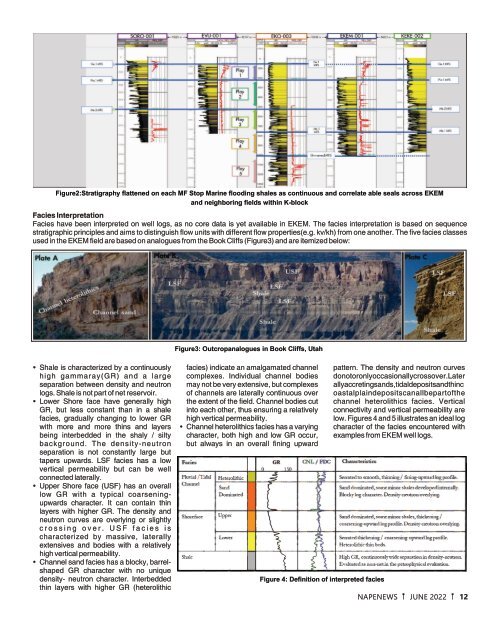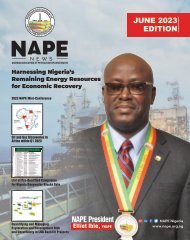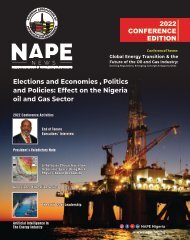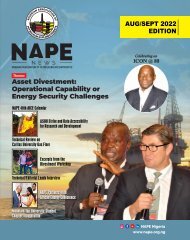NAPENews Magazine June 2022 Edition
June 2022 Edition of the NAPE News Magazine is the Mid-Year Edition. Happy reading.
June 2022 Edition of the NAPE News Magazine is the Mid-Year Edition. Happy reading.
Create successful ePaper yourself
Turn your PDF publications into a flip-book with our unique Google optimized e-Paper software.
Figure2:Stratigraphy flattened on each MF Stop Marine flooding shales as continuous and correlate able seals across EKEM<br />
and neighboring fields within K-block<br />
Facies Interpretation<br />
Facies have been interpreted on well logs, as no core data is yet available in EKEM. The facies interpretation is based on sequence<br />
stratigraphic principles and aims to distinguish flow units with different flow properties(e.g. kv/kh) from one another. The five facies classes<br />
used in the EKEM field are based on analogues from the Book Cliffs (Figure3) and are itemized below:<br />
Figure3: Outcropanalogues in Book Cliffs, Utah<br />
Ÿ Shale is characterized by a continuously<br />
high gammaray(GR) and a large<br />
separation between density and neutron<br />
logs. Shale is not part of net reservoir.<br />
Ÿ Lower Shore face have generally high<br />
GR, but less constant than in a shale<br />
facies, gradually changing to lower GR<br />
with more and more thins and layers<br />
being interbedded in the shaly / silty<br />
background. The density-neutron<br />
separation is not constantly large but<br />
tapers upwards. LSF facies has a low<br />
vertical permeability but can be well<br />
connected laterally.<br />
Ÿ Upper Shore face (USF) has an overall<br />
low GR with a typical coarseningupwards<br />
character. It can contain thin<br />
layers with higher GR. The density and<br />
neutron curves are overlying or slightly<br />
c r o s s i n g o v e r . U S F f a c i e s i s<br />
characterized by massive, laterally<br />
extensives and bodies with a relatively<br />
high vertical permeability.<br />
Ÿ Channel sand facies has a blocky, barrelshaped<br />
GR character with no unique<br />
density- neutron character. Interbedded<br />
thin layers with higher GR (heterolithic<br />
facies) indicate an amalgamated channel<br />
complexes. Individual channel bodies<br />
may not be very extensive, but complexes<br />
of channels are laterally continuous over<br />
the extent of the field. Channel bodies cut<br />
into each other, thus ensuring a relatively<br />
high vertical permeability.<br />
Ÿ Channel heterolithics facies has a varying<br />
character, both high and low GR occur,<br />
but always in an overall fining upward<br />
Figure 4: Definition of interpreted facies<br />
pattern. The density and neutron curves<br />
donotoronlyoccasionallycrossover.Later<br />
allyaccretingsands,tidaldepositsandthinc<br />
oastalplaindepositscanallbepartofthe<br />
channel heterolithics facies. Vertical<br />
connectivity and vertical permeability are<br />
low. Figures 4 and 5 illustrates an ideal log<br />
character of the facies encountered with<br />
examples from EKEM well logs.<br />
NAPENEWS JUNE <strong>2022</strong> 12










